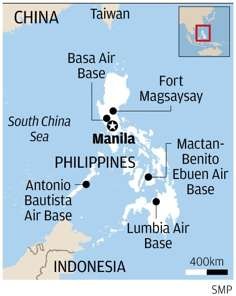
US and Philippines agree on locations for five new military bases, including one in South China Sea
US officials say the pact will also enable it help train the Philippines’ military but isn’t aimed at China.
The US and the Philippines announced on Friday five locations where American forces will have access under a new defence pact, including one facing disputed islands in the South China Sea.
The announcement came at strategic talks in Washington, where the allies reiterated their opposition to the militarisation of outposts in those waters, where six Asian governments have competing claims.

Another of the five Philippine military bases where the US will have access is on southern Mindanao island, where the US is concerned about the presence of Muslim extremist groups.
The 10-year defence pact was signed by US and Philippine officials in 2014, but it only got the green light this January after the Philippine Supreme Court ruled it was constitutional. It is a key part of the Obama administration effort to reassert its presence in Asia.
Philip Goldberg, the US ambassador to the Philippines, said the pact would allow the US to rotate more forces and military assets through that country on a basis of mutual agreement with Manila. It can also conduct construction and position supplies, including for humanitarian relief.
It is not aimed at any country, but rather at improving our bilateral relationship [with the Philippines]
Goldberg said the US is not establishing its own bases as it had in the Philippines until 1992. They were closed amid a tide of Philippine nationalism.
Senior US defence official Amy Searight said Defence Secretary Ash Carter would travel to the Philippines in April to discuss implementation of the pact.
Goldberg said he could not set a date for when US forces would be deployed but he expected movement of supplies and personnel to begin “very soon”.
US Defence Undersecretary Pio Lorenzo Batino said the Philippines was a “reliable partner” and was looking forward to working with the US to develop the agreed-upon locations.
The implementation of the defence pact comes at a time of heightened tension in the South China Sea and will be opposed by China, which views the increased US presence in the region as an attempt at containment.
The locations are at Antonio Bautista Air Base on western Palawan island, which faces the hotly disputed Spratly islands in the South China Sea; Lumbia Air Base on southern Mindanao island; Basa Air Base and Fort Magsaysay, north of the capital, Manila; and Mactan-Benito Ebuen Air Base on Cebu.
US officials say the pact will also enable it help train the Philippines’ military but isn’t aimed at China.
“It is not aimed at any country, but rather at improving our bilateral relationship” with the Philippines and boosting the US rebalance to Asia, Goldberg told reporters.
Searight said the administration has notified Congress that it intends to spend US$50 million on boosting the maritime security of Southeast Asian nations, and most would go to the Philippines.
The Philippines is far outgunned by China, and has sought legal recourse as well as bolstering its security.
By mid-year, an international tribunal is expected to rule on a case brought by the Philippines that challenges the legal basis of China’s sweeping claims in the South China Sea.
Daniel Russel, top US diplomat for East Asia, said that would be a critical moment for “rules-based” future of the region, although China says it is not bound by the arbitration.
Li Jie, a Beijing-based military expert, said the US was determined to curb China’s influence in the region.
“The American is crafty. They seized the chance when China is busy for dealing with North Korea for missile problem in the Northeast, and then work with the Philippines,” he said. “It’s the second time the Philippines decided to open more military bases to the US within this year.
“In January, Manila had offered eight bases for US for building facilities, and China will expect the US to reopen more locations because so far most are air force bases. China will defiantly keep a close eye on whether the US will request to reopen its former large naval base on Subic Bay, which was closed in 1992 and turned into a civilian port.”
Giving speeches on the China Development Forum on Saturday, former Chinese State Council Dai Bingguo said that as the two biggest powers in the world, both China and the US need each other..
“The US will regret when it lost China’s support,” he told the forum.
Henry Kissinger, who also attended the forum, said that he believes China is not attempting to replace the US in the global community: “If there are conflicts between China and the US, it will cause disaster to the whole world as other countries would be force to take a stance.”
Additional reporting by Minnie Chan

